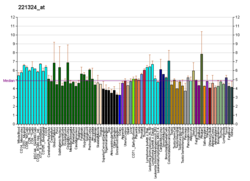
TAS2R16 is a bitter taste receptor and one of the 25 TAS2Rs. TAS2Rs are receptors that belong to the G-protein-coupled receptors (GPCRs) family. These receptors detect various bitter substances found in nature as agonists, and get stimulated. TAS2R16 receptor is mainly expressed within taste buds present on the surface of the tongue and palate epithelium. TAS2R16 is activated by bitter β-glucopyranosides

Taste receptor type 2 member 3 is a protein that in humans is encoded by the TAS2R3 gene.

Taste receptor type 2 member 4 is a protein that in humans is encoded by the TAS2R4 gene.

Taste receptor type 2 member 8 is a protein that in humans is encoded by the TAS2R8 gene.

Taste receptor type 2 member 9 is a protein that in humans is encoded by the TAS2R9 gene.

Taste receptor type 2 member 10 is a protein that in humans is encoded by the TAS2R10 gene. The protein is responsible for bitter taste recognition in mammals. It serves as a defense mechanism to prevent consumption of toxic substances which often have a characteristic bitter taste.

Taste receptor type 2 member 13 is a protein that in humans is encoded by the TAS2R13 gene.

Taste receptor type 2 member 14 is a protein that in humans is encoded by the TAS2R14 gene.

Taste receptor type 2 member 5 is a protein that in humans is encoded by the TAS2R5 gene.

Taste receptor type 2 member 7 is a protein that in humans is encoded by the TAS2R7 gene.

Taste receptor type 1 member 1 is a protein that in humans is encoded by the TAS1R1 gene.

T1R2 - Taste receptor type 1 member 2 is a protein that in humans is encoded by the TAS1R2 gene.

Taste receptor type 1 member 3 is a protein that in humans is encoded by the TAS1R3 gene. The TAS1R3 gene encodes the human homolog of mouse Sac taste receptor, a major determinant of differences between sweet-sensitive and -insensitive mouse strains in their responsiveness to sucrose, saccharin, and other sweeteners.

Taste receptor type 2 member 40 is a protein that in humans is encoded by the TAS2R40 gene.

Taste receptor type 2 member 41 is a protein that in humans is encoded by the TAS2R41 gene.

Taste receptors for bitter substances (T2Rs/TAS2Rs) belong to the family of G-protein coupled receptors and are related to class A-like GPCRs. There are 25 known T2Rs in humans responsible for bitter taste perception.

Taste receptor type 2 member 30 is a protein that in humans is encoded by the TAS2R30 gene.

Taste receptor type 2 member 19 is a protein that in humans is encoded by the TAS2R19 gene. It seems to be involved in the perception of salt and bitter tastes.

Taste receptor type 2 member 50 is a protein that in humans is encoded by the TAS2R50 gene.

Taste receptor type 2 member 60 is a protein that in humans is encoded by the TAS2R60 gene.







